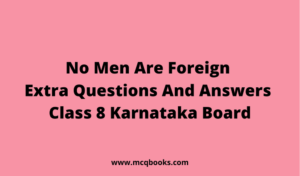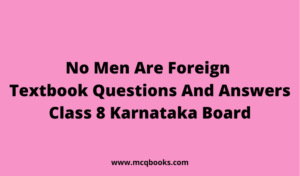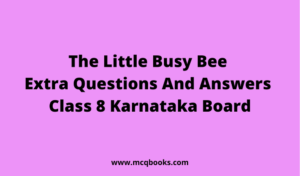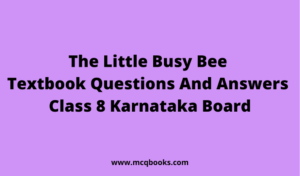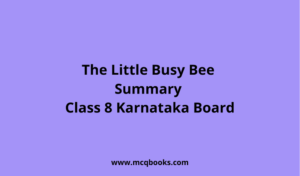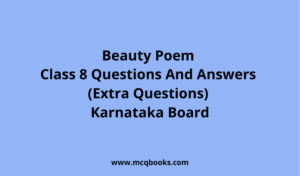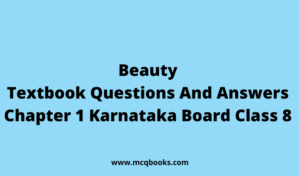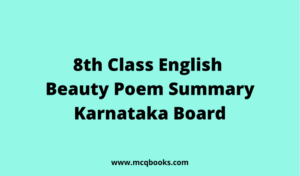No Men Are Foreign Poem Summary Karnataka Board Class 8
English is a difficult subject for many people to learn. Some students may become frustrated and give up, but here’s No Men Are Foreign Poem Summary Karnataka Board Class 8 to help you maintain your momentum! This No Men Are Foreign Poem Summary will provide all necessary information needed in order to study KSEEB Class 8 English successfully at home or school.
The No Men Are Foreign Poem Summary, Karnataka Board Class 8 makes it easier to understand the story. Understanding every detail of a story is important for scoring higher on an exam and expert writers have made sure that you know how everything flows together by summarizing perfectly!

Summary
No Men are Foreign Summary – This poem ‘No Men are Foreign’ is all about human beings. Also, it tells that every human being that lives on this earth are our brothers and are the same. Moreover, we all have some kind of body and needs sun, air, water, and clothes to cover us. We all walk the land and feed ourselves with the harvest of this earth. Upon death, people will bury us in this same land. Also, we all do work and sleep and wake up, loves, and wants to love in return for others. But we (human beings) hate each other and because of this, we live on by hating and fighting with one another. Further, it is humans who pollute the environment by taking into consideration its bad impact on other people.
Theme
The theme of the poem “No Men are Foreign” is the oneness of mankind underneath the superficial differences of colour, race, nationality and faith. It states that all human beings are brothers and sisters. Those who spread hatred and wage wars are criminals and deserve to be condemned.
Background
‘No Men Are Foreign’ by James Kirkup is a subtle poem, talks about the impact of War on the life of people. Being published in 1966, the poem calls attention to the fact that humans are all the same, despite the differences in race, geography, or language.
Line by line analysis
Stanza 1
Beneath: under, Strange: unknown
In the first line, the poet says that no men are strange, and no country is foreign. So, he is attempting to remove the borders from the Earth which have been erected to separate different countries. Then only no country will be foreign. We will feel every country as our land when there will be no borders, everyone will be free to move around. The poet wants to say that the entire Earth is one and all the people who live on this Earth belong to one human race. Then he says that inside the uniforms worn by soldiers of different countries, the human being is the same.
God has similarly made all of us. All breath in the same way. Then he says that all the soldiers are our brothers – we all walk upon the same ‘Mother Earth’ and upon our death, shall lie in the grave in the same Earth.
Stanza 2
‘They’ refers to those people who belong to other countries. We call them foreigners and discriminate against them and fight with them also. The poet says that nature has given all the bounties to all people also just like he has given to us. Everyone gets sunlight, air and water in equal measure which means that God does not differentiate between people from different countries. We all do farming during the time of peace when there is no war. We live a relaxed life and eat the things given to us by nature.
Further, he adds that the way we starve during wars and wintertime is the same for those belonging to other countries. Even they don’t get food at that time. So, he wants to say that foreigners who belong to another country and we, both are the same. And then the poet says that even their hands are the same as ours, they work very hard just like we do. He is giving all these examples to convey to the reader that there is no difference between us and the people belonging to another country.
Stanza 3
The poet asks the reader to remember something. He says that we should keep in mind that the people of another country, whom we think to be our enemies, have been bestowed by God with a similar appearance to us. God has given them eyes like ours which open when awake and close when we are asleep. Similarly, he has given them strength which we can win through love. Then he says that in every country, in every land there is one common thing, that is life. Life means all the things that are living. And if we can recognize them and if we can understand their feelings and realize that they are like us, then there will be no fights or wars between us.
Stanza 4
The poet says that we should remember that whenever someone tells us to hate a person from another country, to think of him as our enemy, and whenever we think of someone to be our enemy, then we deprive ourselves, we cheat ourselves, and we condemn ourselves. He says that we should stay away from such negativity. We should not consider anyone to be our enemy. During a war, both parties must bear the loss. And that is why the poet says that war is not in our favour. He says that whenever we pick any weapon against someone, we should remember one thing
Stanza 5
defile: make dirty; pollute
outrage the innocence of: violate the purity of We should keep in mind that whenever we pick weapons against any person, we make the Earth dirty because weapons kill people and their bodies that fall on the Earth make it dirty. Whenever war happens, it leads to a lot of bloodsheds, fire and death. These dead bodies accumulate on the Earth and it makes it impure. The fire of war which erupts, the smoke which comes out, the dust which fills the air – it is so dirty that it pollutes and outrages the purity of the air. With all these things the poet wants to give us a message that we should not indulge in war. Finally, he ends the poem by writing the first line in reverse and saying that Remember, no men are foreign, and no countries strange
About The Author:
James Falconer Kirkup was an English writer. He was born on 23rd April 1918. He was a poet, translator, and travel writer. His writings helped him to become a Fellow of the Royal Society of Literature in 1962. He died on 10th May 2009. In this poem, the poet wants us to understand that all are equal in this world, and we should live in peace with one another.
Literary devices
Rhyme Scheme – The entire poem is written in free verse. There is no rhyme scheme in the poem.
The literary devices used are as follows –
Alliteration: The repetition of a consonant sound in two or more closely placed words is called alliteration. The instances of alliteration in the poem are
Stanza 1 – Body, breathes ‘b’ sound is repeated
Stanza 2 – war’s, winter ‘w’ sound is repeated
Metaphor
Stanza 1 – Uniform refers to the military of different countries
Stanza 2 – wars time is compared to the winter season
Repetition: It is used in the entire poem.
‘Remember’ word is repeated 5 times in this poem.
‘Remember, no men are strange, no countries foreign’ is repeated in stanza 1 and stanza 5
Enjambment – running lines of poetry from one line to the next without using any kind of punctuation to indicate a stop. Instances of enjambment in the poem are as follows-
a)Stanza 1 – line 2, 3 and 4
b)Stanza 2 – line 3 and 3
c)Stanza 3 – line 1, 2, and 3
d)Stanza 4 – line 1 and 2
e)Stanza 5 – Line 2 and 3.
It is important for a learner to read stories thoroughly and accurately in order to score better in KSEEB Class 8 English exams. No Men Are Foreign Poem Summary In English Karnataka Board Class 8 has been given by experts to ensure that the story can be easily understood. Hope you found this No Men Are Foreign Poem Summary helpful.
Questions And Answers
What is the main message of the poem no men are foreign?
The central theme of the poem No Men are Foreign revolves around the brotherhood of all humankind. The poet points out that all our boundaries and differences are human-made. Throughout the poem, James Kirkup tries to show the similarities between all humans.
What are the lines in the poem no men are foreign?
Remember, no men are strange, no countries foreign Beneath all uniforms, a single body breathes Like ours: the land our brothers walk upon Is earth like this, in which we all shall lie.
What message does the poem no men are foreign convey?
The message of the poem is that no men are strangers in this world because all people on earth are connected through their common humanity. We share a number of similarities even with our supposed enemies. They, too, aware of the sun and air and water, Are fed by peaceful harvests, by war’s long winter starv ‘d.
What according to the poet are we doing when we hate others?
According to the poet, we will be dispossessing ourselves When we hate others. We should realize that we are involving ourselves in our own destruction and downfall.

